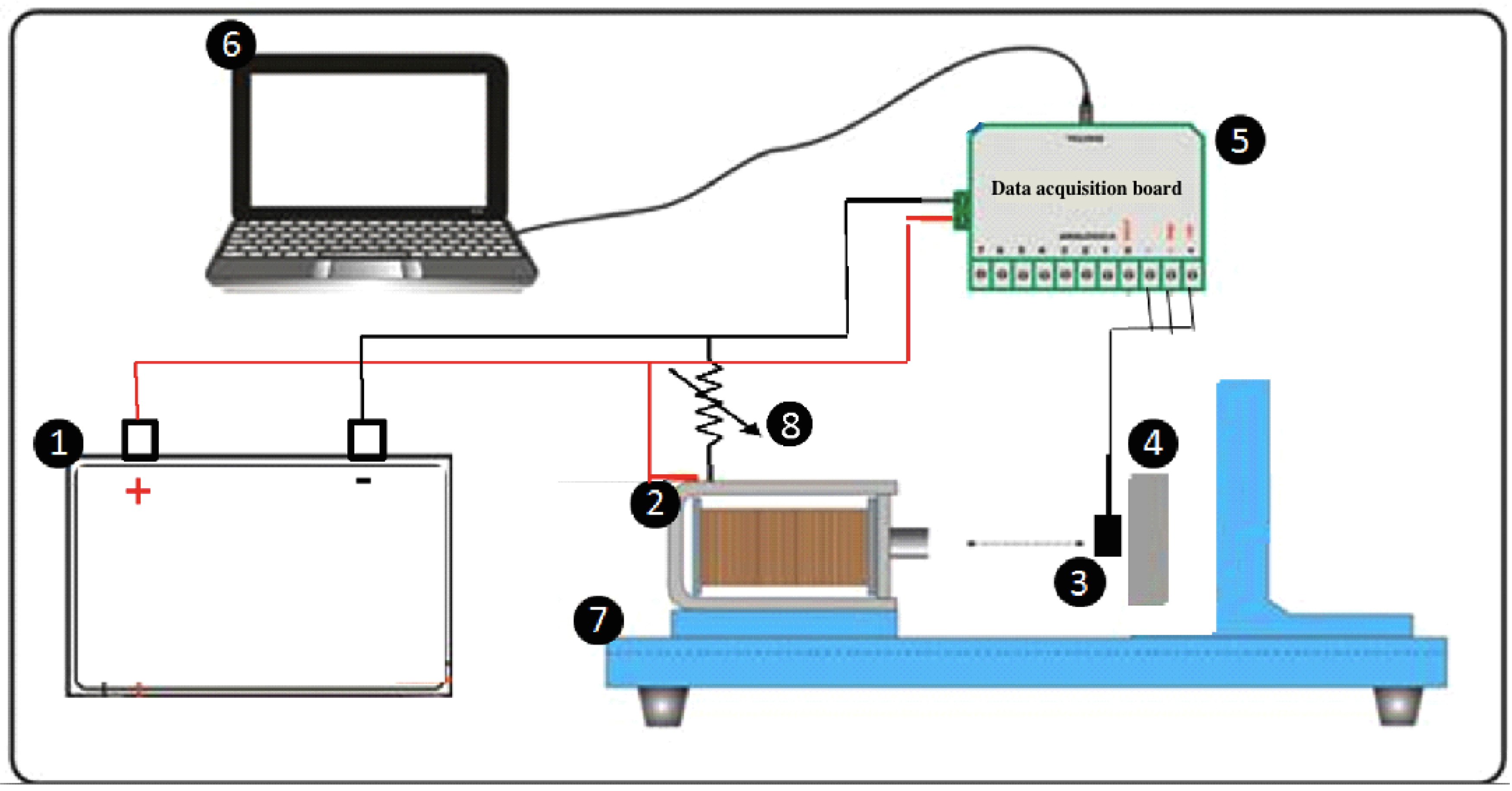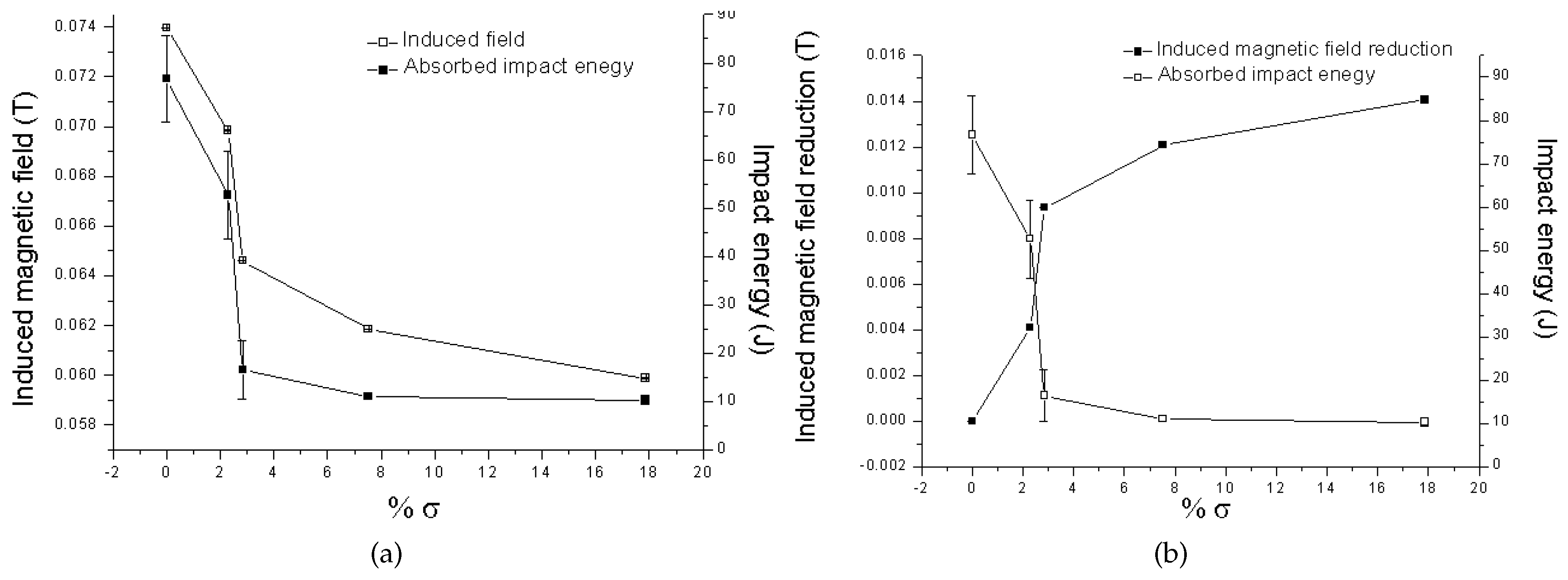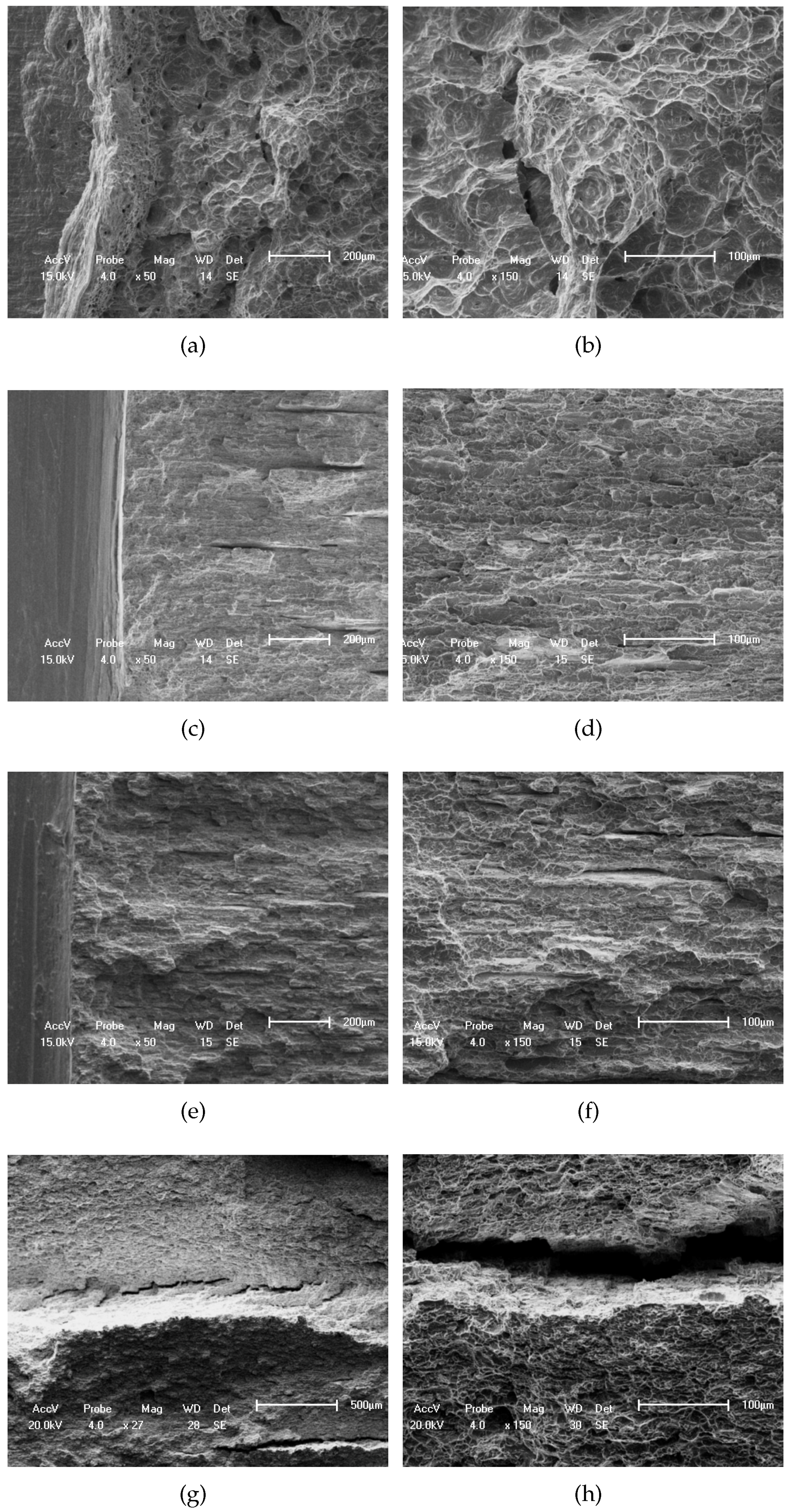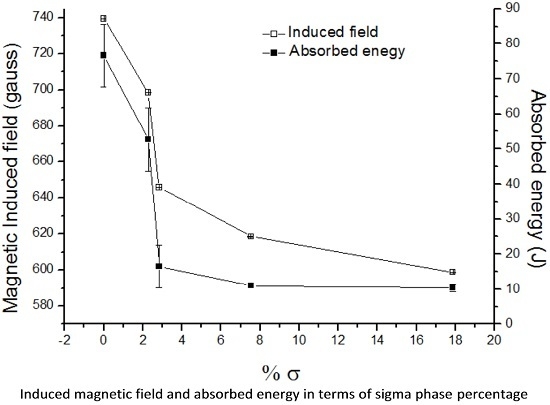Classification of Induced Magnetic Field Signals for the Microstructural Characterization of Sigma Phase in Duplex Stainless Steels
Abstract
:1. Introduction
2. Experimental Procedures
2.1. Induced Magnetic Fields
2.2. Machine Learning
Performance Evaluation Metrics
3. Results
3.1. Materials Characterization
3.2. Computer Classification
4. Conclusions
Acknowledgments
Author Contributions
Conflicts of Interest
References
- Martins, M.; Casteletti, L.C. Microstructural characteristics and corrosion behavior of a super duplex stainless steel casting. Mater. Charact. 2009, 60, 150–155. [Google Scholar] [CrossRef]
- Badji, R.; Bouabdallah, M.; Bacroix, B.; Kahloun, C.; Bettahar, K.; Kherrouba, N. Effect of solution treatment temperature on the precipitation kinetic of σ-phase in 2205 duplex stainless steel welds. Mater. Sci. Eng. A 2008, 496, 447–454. [Google Scholar] [CrossRef]
- Jiang, Z.; Chen, X.; Huang, H.; Liu, X. Grain refinement of Cr25Ni5Mo1.5 duplex stainless steel by heat treatment. Mater. Sci. Eng. A 2003, 363, 263–267. [Google Scholar] [CrossRef]
- Chen, T.; Weng, K.; Yang, J. The effect of high-temperature exposure on the microstructural stability and toughness property in a 2205 duplex stainless steel. Mater. Sci. Eng. A 2002, 338, 259–270. [Google Scholar] [CrossRef]
- Pohl, M.; Storz, O.; Glogowski, T. Effect of intermetallic precipitations on the properties of duplex stainless steel. Mater. Charact. 2007, 58, 65–71. [Google Scholar] [CrossRef]
- Normando, P.G.; Moura, E.P.; Souza, J.A.; Tavares, S.S.; Padovese, L.R. Ultrasound, eddy current and magnetic Barkhausen noise as tools for sigma phase detection on a UNS S31803 duplex stainless steel. Mater. Sci. Eng. A 2010, 527, 2886–2891. [Google Scholar] [CrossRef]
- Tavares, S.; Pardal, J.; Guerreiro, J.; Gomes, A.; da Silva, M. Magnetic detection of sigma phase in duplex stainless steel UNS S31803. J. Magn. Magn. Mater. 2010, 322, L29–L33. [Google Scholar] [CrossRef]
- Sieurin, H.; Sandström, R. Sigma phase precipitation in duplex stainless steel 2205. Mater. Sci. Eng. A 2007, 444, 271–276. [Google Scholar] [CrossRef]
- Muthupandi, V.; Srinivasan, P.B.; Seshadri, S.; Sundaresan, S. Effect of weld metal chemistry and heat input on the structure and properties of duplex stainless steel welds. Mater. Sci. Eng. A 2003, 358, 9–16. [Google Scholar] [CrossRef]
- Pardal, J.M.; Tavares, S.S.M.; Fonseca, M.P.C.; da Silva, M.R.; Ferreira, M.L.R. Study of deleterious phase precipitation under continuous cooling of superduplex stainless steel UNS S32750. Mater. Sci. Technol. 2012, 28, 295–302. [Google Scholar] [CrossRef]
- Junior, C.M.S.; Abreu, H.F.G.; Tavares, S.S.M.; Rebello, J.M.A. The σ phase formation in annealed UNS S31803 duplex stainless steel: Texture aspects. Mater. Charact. 2008, 59, 1301–1306. [Google Scholar]
- Sathirachinda, N.; Pettersson, R.; Pan, J. Depletion effects at phase boundaries in 2205 duplex stainless steel characterized with {SKPFM} and TEM/EDS. Corros. Sci. 2009, 51, 1850–1860. [Google Scholar] [CrossRef]
- Moura, V.S.; Lima, L.D.; Pardal, J.M.; Kina, A.Y.; Corte, R.R.A.; Tavares, S.S.M. Influence of microstructure on the corrosion resistance of the duplex stainless steel UNS S31803. Mater. Charact. 2008, 59, 1127–1132. [Google Scholar] [CrossRef]
- Zou, D.; Han, Y.; Zhang, W.; Fan, G. Phase Transformation and Its Effects on Mechanical Properties and Pitting Corrosion Resistance of 2205 Duplex Stainless Steel. J. Iron Steel Res. Int. 2010, 17, 67–72. [Google Scholar] [CrossRef]
- Zhang, W.; Jiang, L.; Hu, J.; Song, H. Effect of ageing on precipitation and impact energy of 2101 economical duplex stainless steel. Mater. Charact. 2009, 60, 50–55. [Google Scholar] [CrossRef]
- Nilsson, J.O.; Kangas, P.; Wilson, A.; Karlsson, T. Mechanical properties, microstructural stability and kinetics of σ-phase formation in 29Cr-6Ni-2Mo-0.38N superduplex stainless steel. Metall. Mater. Trans. A 2000, 31, 35–45. [Google Scholar] [CrossRef]
- Mohapatra, J.N.; Kamada, Y.; Kikuchi, H.; S. Kobayashi, J.E.; Park, D.G.; Cheong, Y.M. Evaluation of Embrittlement in Isochronal Aged Fe-Cr Alloys by Magnetic Hysteresis Loop Technique. Metall. Mater. Trans. A 2011, 16, 173–176. [Google Scholar] [CrossRef]
- Mohapatra, J.; Kamada, Y.; Murakami, T.; Echigoya, J.; Kikuchi, H.; Kobayashi, S. Magnetic hysteresis loop technique as a tool for the evaluation of σ phase embrittlement in Fe-Cr alloys. J. Magn. Magn. Mater. 2013, 327, 71–75. [Google Scholar] [CrossRef]
- Lo, K.; Lai, J.; Shek, C.; Li, D. Magnetic and transformation behaviour of duplex stainless steels under non-isothermal conditions and temperature-fluctuation monitoring. Mater. Sci. Eng. A 2007, 452–453, 149–160. [Google Scholar] [CrossRef]
- Lo, K.; Lai, J. Microstructural characterisation and change in a.c. magnetic susceptibility of duplex stainless steel during spinodal decomposition. J. Nucl. Mater. 2010, 401, 143–148. [Google Scholar] [CrossRef]
- Ghanei, S.; Kashefi, M.; Mazinani, M. Eddy current nondestructive evaluation of dual phase steel. Mater. Des. 2013, 50, 491–496. [Google Scholar] [CrossRef]
- De Macedo Silva, E.; Leite, J.P.; de França Neto, F.A.; Leite, J.P.; Fialho, W.M.; de Albuquerque, V.C.; Tavares, J.R. Evaluation of the Magnetic Permeability for the Microstructural Characterization of a Duplex Stainless Steel. J. Test. Eval. 2016, 44. [Google Scholar] [CrossRef]
- Camerini, C.; Sacramento, R.; Areiza, M.; Rocha, A.; Santos, R.; Rebello, J.; Pereira, G. Eddy current techniques for super duplex stainless steel characterization. J. Magn. Magn. Mater. 2015, 388, 96–100. [Google Scholar] [CrossRef]
- Rebello, J.; Areiza, M.; Camerini, C.; Rocha, J. Saturated low frequency eddy current technique applied to microstructure phase quantification in duplex stainless steel. In Proceedings of the 2013 Far East Forum on Nondestructive Evaluation/Testing: New Technology Application (FENDT), Jinan, China, 17–20 June 2013; pp. 1–7.
- Uchimoto, T.; Takagi, T.; Konoplyuk, S.; Abe, T.; Huang, H.; Kurosawa, M. Eddy current evaluation of cast irons for material characterization. J. Magn. Magn. Mater. 2003, 258–259, 493–496. [Google Scholar] [CrossRef]
- Rebello, J.M.A.; Sacramento, R.; Areiza, M.C.L.; de Assis, K.S. Quantification of Sigma Phase Precipitation by Magnetic Non Destructive Testing. In Electromagnetic Nondestructive Evaluation—Studies in Applied Electromagnetics and Mechanics; IOS Press: Amsterdam, The Netherlands, 2010; Volume 35, pp. 311–321. [Google Scholar]
- Nunes, T.M.; de Albuquerque, V.H.C.; Papa, J.P.; Silva, C.C.; Normando, P.G.; Moura, E.P.; Tavares, J.M.R. Automatic microstructural characterization and classification using artificial intelligence techniques on ultrasound signals. Expert Syst. Appl. 2013, 40, 3096–3105. [Google Scholar] [CrossRef]
- De Albuquerque, V.H.C.; de Macedo Silva, E.; Leite, J.P.; de Moura, E.P.; de Araújo Freitas, V.L.; Tavares, J.M.R. Spinodal decomposition mechanism study on the duplex stainless steel UNS S31803 using ultrasonic speed measurements. Mater. Des. 2010, 31, 2147–2150. [Google Scholar] [CrossRef]
- De Albuquerque, V.H.C.; Silva, C.C.; Normando, P.G.; Moura, E.P.; Tavares, J.M.R. Thermal aging effects on the microstructure of Nb-bearing nickel based superalloy weld overlays using ultrasound techniques. Mater. Des. 2012, 36, 337–347. [Google Scholar] [CrossRef]
- De Macedo Silva, E.; de Albuquerque, V.H.C.; Leite, J.P.; Varela, A.C.G.; de Moura, E.P.; Tavares, J.M.R. Phase transformations evaluation on a UNS S31803 duplex stainless steel based on nondestructive testing. Mater. Sci. Eng. A 2009, 516, 126–130. [Google Scholar] [CrossRef]
- De Albuquerque, V.H.C.; de A. Melo, T.A.; de Oliveira, D.F.; Gomes, R.M.; Tavares, J.M.R. Evaluation of grain refiners influence on the mechanical properties in a CuAlBe shape memory alloy by ultrasonic and mechanical tensile testing. Mater. Des. 2010, 31, 3275–3281. [Google Scholar] [CrossRef]
- De Araújo Freitas, V.L.; de Albuquerque, V.H.C.; de Macedo Silva, E.; Silva, A.A.; Tavares, J.M.R. Nondestructive characterization of microstructures and determination of elastic properties in plain carbon steel using ultrasonic measurements. Mater. Sci. Eng. A 2010, 527, 4431–4437. [Google Scholar] [CrossRef]
- Tavares, J.M.R.; Rebouças Filho, P.P.; Cavalcante, T.D.S.; de Albuquerque, V.H.C. Brinell and Vickers hardness measurement using image processing and analysis techniques. J. Test. Eval. 2009, 38, 1–7. [Google Scholar]
- De Macêdo Peixoto, F.; de Souza Rebouças, E.; de Lima Xavier, F.G.; Rebouças Filho, P.P. Software development for ductile cast iron graphite nodules density calculation using Digital Image Processing. Matéria (Rio de Janeiro) 2015, 20, 262–272. [Google Scholar]
- Rebouças Filho, P.P.; Moreira, F.D.L.; Xavier, F.G.d.L.; Gomes, S.L.; Santos, J.C.d.; Freitas, F.N.C.; Freitas, R.G. New Analysis Method Application in Metallographic Images through the Construction of Mosaics Via Speeded Up Robust Features and Scale Invariant Feature Transform. Materials 2015, 8, 3864–3882. [Google Scholar] [CrossRef]
- De Albuquerque, V.H.C.; Barbosa, C.V.; Silva, C.C.; Moura, E.P.; Filho, P.P.R.; Papa, J.P.; Tavares, J.M.R.S. Ultrasonic Sensor Signals and Optimum Path Forest Classifier for the Microstructural Characterization of Thermally-Aged Inconel 625 Alloy. Sensors 2015, 15, 12474. [Google Scholar] [CrossRef] [PubMed]
- Moreira, F.D.L.; Kleinberg, M.N.; Arruda, H.F.; Freitas, F.N.C.; Parente, M.M.V.; de Albuquerque, V.H.C.; Rebouças Filho, P.P. A novel Vickers hardness measurement technique based on Adaptive Balloon Active Contour Method. Expert Syst. Appl. 2016, 45, 294–306. [Google Scholar] [CrossRef]
- De Albuquerque, V.H.C.; de Alexandria, A.R.; Cortez, P.C.; Tavares, J.M.R. Evaluation of multilayer perceptron and self-organizing map neural network topologies applied on microstructure segmentation from metallographic images. NDT E Int. 2009, 42, 644–651. [Google Scholar] [CrossRef]
- Albuquerque, V.H.C.; Rebouças Filho, P.P.; Cavalcante, T.S.; Tavares, J.M.R.S. New computational solution to quantify synthetic material porosity from optical microscopic images. J. Microsc. 2010, 240, 50–59. [Google Scholar] [CrossRef] [PubMed]
- Albuquerque, V.H.C.D.; Tavares, J.M.R.; Cortez, P.C. Quantification of the microstructures of hypoeutectic white cast iron using mathematical morphology and an artificial neural network. Int. J. Microstruct. Mater. Prop. 2010, 5, 52–64. [Google Scholar] [CrossRef]
- Albuquerque, V.H.C.; Tavares, J.M.R.S.; Durão, L.M.D. Evaluation of Delamination Damage on Composite Plates using an Artificial Neural Network for the Radiographic Image Analysis. J. Compos. Mater. 2010, 44, 1139–1159. [Google Scholar] [CrossRef]
- De Albuquerque, V.H.C.; Silva, C.C.; Menezes, T.I.d.S.; Farias, J.P.; Tavares, J.M.R.S. Automatic evaluation of nickel alloy secondary phases from SEM images. Microsc. Res. Tech. 2011, 74, 36–46. [Google Scholar] [CrossRef] [PubMed]
- De Albuquerque, V.H.C.; Cortez, P.C.; de Alexandria, A.R.; Tavares, J.M.R. A new solution for automatic microstructures analysis from images based on a backpropagation artificial neural network. Nondestruct. Test. Eval. 2008, 23, 273–283. [Google Scholar] [CrossRef]
- Papa, J.P.; Falcao, A.X.; Suzuki, C.T.N. Supervised Pattern Classification based on Optimum-Path Forest. Int. J. Imaging Syst. Technol. 2009, 19, 120–131. [Google Scholar] [CrossRef]
- Papa, J.P.; Falcao, A.X.; de Albuquerque, V.H.C.; Tavares, J.M.R.S. Efficient supervised optimum-path forest classification for large datasets. Pattern Recognit. 2012, 45, 512–520. [Google Scholar] [CrossRef]
- Iwashita, A.; Papa, J.; Souza, A.; Falcao, A.; Lotufo, R.; Oliveira, V.; de Albuquerque, V.H.C.; Tavares, J.M.R. A path- and label-cost propagation approach to speedup the training of the optimum-path forest classifier. Pattern Recogniti. Lett. 2014, 40, 121–127. [Google Scholar] [CrossRef]
- Osaku, D.; Nakamura, R.; Pereira, L.; Pisani, R.; Levada, A.; Cappabianco, F.; Falcao, A.; Papa, J.P. Improving land cover classification through contextual-based optimum-path forest. Inf. Sci. 2015, 324, 60–87. [Google Scholar] [CrossRef]
- Luz, E.J.S.; Nunes, T.M.; de Albuquerque, V.H.C.; Papa, J.P.; Menotti, D. ECG arrhythmia classification based on optimum-path forest. Expert Syst. Appl. 2013, 40, 3561–3573. [Google Scholar] [CrossRef]
- Nunes, T.M.; Coelho, A.L.; Lima, C.A.; Papa, J.P.; de Albuquerque, V.H.C. EEG signal classification for epilepsy diagnosis via optimum path forest - A systematic assessment. Neurocomputing 2014, 136, 103–123. [Google Scholar] [CrossRef]
- Papa, J.P.; Nakamura, R.Y.; de Albuquerque, V.H.C.; Falcao, A.X.; Tavares, J.M.R. Computer techniques towards the automatic characterization of graphite particles in metallographic images of industrial materials. Expert Syst. Appl. 2013, 40, 590–597. [Google Scholar] [CrossRef]
- Pisani, R.; Nakamura, R.M.; Riedel, P.S.; Zimback, C.L.; Falcao, A.X.; Papa, J. Toward Satellite-Based Land Cover Classification Through Optimum-Path Forest. IEEE Trans. Geosci. Remote Sens. 2014, 52, 6075–6085. [Google Scholar] [CrossRef]
- Saito, P.T.M.; Nakamura, Y.M.R.; Amorim, W.P.; Papa, J.P.; Rezende, P.J.; Falcao, A.X. Choosing the Most Effective Pattern Classification Model under Learning-Time Constraint. PLoS ONE 2015, 10, e0129947. [Google Scholar] [CrossRef] [PubMed]
- Suzuki, C.; Gomes, J.; Falcao, A.; Papa, J.; Hoshino-Shimizu, S. Automatic Segmentation and Classification of Human Intestinal Parasites From Microscopy Images. IEEE Trans. Biomed. Eng. 2013, 60, 803–812. [Google Scholar] [CrossRef] [PubMed]
- Pereira, C.R.; Nakamura, R.Y.; Costa, K.A.; Papa, J.P. An Optimum-Path Forest framework for intrusion detection in computer networks. Eng. Appl. Artif. Intell. 2012, 25, 1226–1234. [Google Scholar] [CrossRef]
- Burges, C.J.C. A tutorial on support vector machines for pattern recognition. Data Min. Knowl. Discov. 1998, 2, 121–167. [Google Scholar] [CrossRef]
- Chang, C.C.; Lin, C.J. LIBSVM: A Library for Support Vector Machines. ACM Trans. Intell. Syst. Technol. 2011, 2. [Google Scholar] [CrossRef]
- Rebouças Filho, P.P.; Cortez, P.C.; da Silva Barros, A.C.; de Albuquerque, V.H.C. Novel Adaptive Balloon Active Contour Method based on internal force for image segmentation—A systematic evaluation on synthetic and real images. Expert Syst. Appl. 2014, 41, 7707–7721. [Google Scholar] [CrossRef]
- Neto, E.C.; Gomes, S.L.; Rebouças Filho, P.P.; de Albuquerque, V.H.C. Brazilian vehicle identification using a new embedded plate recognition system. Measurement 2015, 70, 36–46. [Google Scholar] [CrossRef]
- Neto, E.C.; Reboucas, E.S.; de Moraes, J.L.; Gomes, S.L.; Filho, P.P.R. Development control parking access using techniques Digital Image Processing and Applied Computational Intelligence. IEEE Latin Am. Trans. 2015, 13, 272–276. [Google Scholar] [CrossRef]
- Duda, R.O.; Hart, P.E.; Stork, D.G. Pattern Classification, 2nd ed.; Wiley-Interscience: New York City, NY, USA, 2000. [Google Scholar]
- Fargas, G.; Anglada, M.; Mateo, A. Effect of the annealing temperature on the mechanical properties, formability and corrosion resistance of hot-rolled duplex stainless steel. J. Mater. Process. Technol. 2009, 209, 1770–1782. [Google Scholar] [CrossRef]
- Martins, M.; Forti, L.R.N. Effect of aging on impact properties of ASTM A890 Grade 1C super duplex stainless steel. Mater. Charact. 2008, 59, 162–166. [Google Scholar] [CrossRef]








© 2016 by the authors; licensee MDPI, Basel, Switzerland. This article is an open access article distributed under the terms and conditions of the Creative Commons Attribution (CC-BY) license (http://creativecommons.org/licenses/by/4.0/).
Share and Cite
Silva, E.M.; Marinho, L.B.; Filho, P.P.R.; Leite, J.P.; Leite, J.P.; Fialho, W.M.L.; De Albuquerque, V.H.C.; Tavares, J.M.R.S. Classification of Induced Magnetic Field Signals for the Microstructural Characterization of Sigma Phase in Duplex Stainless Steels. Metals 2016, 6, 164. https://doi.org/10.3390/met6070164
Silva EM, Marinho LB, Filho PPR, Leite JP, Leite JP, Fialho WML, De Albuquerque VHC, Tavares JMRS. Classification of Induced Magnetic Field Signals for the Microstructural Characterization of Sigma Phase in Duplex Stainless Steels. Metals. 2016; 6(7):164. https://doi.org/10.3390/met6070164
Chicago/Turabian StyleSilva, Edgard M., Leandro B. Marinho, Pedro P. Rebouças Filho, João P. Leite, Josinaldo P. Leite, Walter M. L. Fialho, Victor Hugo C. De Albuquerque, and João Manuel R. S. Tavares. 2016. "Classification of Induced Magnetic Field Signals for the Microstructural Characterization of Sigma Phase in Duplex Stainless Steels" Metals 6, no. 7: 164. https://doi.org/10.3390/met6070164
APA StyleSilva, E. M., Marinho, L. B., Filho, P. P. R., Leite, J. P., Leite, J. P., Fialho, W. M. L., De Albuquerque, V. H. C., & Tavares, J. M. R. S. (2016). Classification of Induced Magnetic Field Signals for the Microstructural Characterization of Sigma Phase in Duplex Stainless Steels. Metals, 6(7), 164. https://doi.org/10.3390/met6070164








